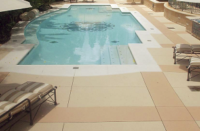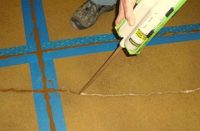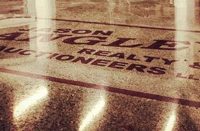

When California contractor Julio A. Hallack agreed to renovate the floors in Modesto’s State Theater — once a prime example of art deco architecture — he knew he had a big job ahead of him. Half the lobby consisted of terrazzo installed in 1934 and the other half was covered by filthy carpet that reeked from years of spilled beer and wine.
Many areas under the carpet had been patched with unbonded mortar. These would have to be cleaned out and patched again. Other sections of carpet had been laid over wood. These areas would require additional strengthening, in the form of metal lath, to accommodate an overlay.
Another problem: a one-inch height difference between the terrazzo and carpet. It had been filled with mortar that was now very loose.
Hallack’s challenges were to make the floor both sound and level and then to create a gentle transition between the lobby and the ramp to accommodate wheelchairs. Once that was done, he could get to the fun part — returning the decorative design to its former glory.

Hallack, owner of Concrete Innovations by Hallack, was ready for the challenge. The eye-catching results he achieved are a showcase for his skill and artistry in decorative applications.
Architect’s drawings provide inspiration
Hallack first consulted the architect’s original drawings. With those in hand, he set out to restore the floors.
After the patched areas had been filled with Quikrete and the floor screeded to make it level, Hallack installed Miracote Repair Mortar, a polymer-modified resurfacing compound that can be installed in any thickness from 2″ to featheredge. Using the product, he says, allowed him to bring the ramp out at a soft angle so that wheelchairs could easily negotiate the transition.

After all the repairs were done and the floor was leveled, he installed two base coats of Miracote Protective Coatings with color. Then he applied two thin coats of Miracote smooth protective coatings. These coatings do not have sand in them and create a very, very smooth finish.
Then he sawcut the design and filled the cuts with colored grout to add extra definition to the design. Acid stains were applied, and then the project was sealed. The floor — whose design represents film (going left to right) and a ray of light that projects from outside the theater towards its center — had become a powerful piece of art.

Maintenance: an important component
After the project was completed, the theater’s board of directors agreed to monthly maintenance, an essential component to maintaining the floor’s beauty. Once a month, Hallack’s crew goes in at night and strips off the top layer of sealer. Then they remove any major marks from the floor, buff it, and put on a coat of high-gloss sealer. “It looks more beautiful every time we do it,” Hallack says.
After paying his crew, himself and his suppliers, Hallack donated his profits back to the nonprofit theater group. His work has more than paid off, he says, by the free advertising he has received from the project and the satisfaction of having brought the building back to its original grandeur. “We felt motivated to invest back into our community,” he says, “and that has provided our company with unlimited opportunities.”
 |
 |
 |
 |
 |
| The new floors at Modesto’s State Theater radiate light in more ways than one. | ||||












